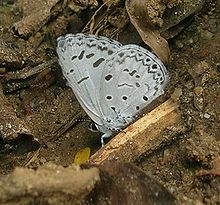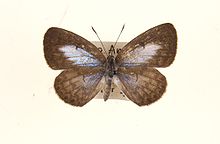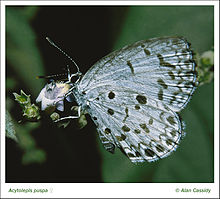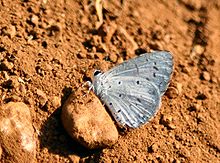- Acytolepis puspa
-
Common Hedge Blue Scientific classification Kingdom: Animalia Phylum: Arthropoda Class: Insecta Order: Lepidoptera Family: Lycaenidae Genus: Acytolepis Species: A. puspa Binomial name Acytolepis puspa
(Horsfield, 1828)Synonyms - Lycaenopsis puspa
The Common Hedge Blue (Acytolepis puspa)[1][2] is a small butterfly found in India, Myanmar, Sri Lanka, Philippines, Borneo and New Guinea[3] that belongs to the Lycaenids or Blues family.
Contents
Taxonomy
The butterfly was earlier known as Lycaenopsis puspa (Toxopeus).[3] It is the type species for the genus Acytolepis[1][2][4].
Description
- See glossary for terms used
 Male. Museum specimen from Malaya
Male. Museum specimen from Malaya
Wet-season brood. male. Upperside: violaceous blue, with brilliant iridescent tints in certain lights. Fore wing: the costa, apex and termen bordered with black, this edging narrows from base to the middle of the costa, then broadens greatly at apex, where it occupies the apical fourth of the wing, and is again narrowed below vein 4, whence it is continued as an even band to the tornus; on the disc beyond the apex of the cell the groundcolour is sensibly paler, and the dark markings of the cell are faintly visible by transparency from below. Hind wing: the costa very broadly, the termen much more narrowly black:; the black bordering on the latter consists of a series of rounded coalescent spots, which on the inner side are margined by faint dark lunules; these are formed not by actual scaling but by the dark markings of the underside which show through more or less clearly.
 From the Eastern Ghats, India
From the Eastern Ghats, India
Underside: slightly bluish white; the markings, some black, some dusky, but all large and distinct. Fore wing: a short bar on the discocellulars, an anteriorly inwardly curved, transverse, discal series of seven, more or less elongate spots, of which the spot in interspace 2 is vertical and sinuous, the next above it irregularly oval and obliquely placed, the next smaller and almost round, the fourth placed almost longitudinally, forms a short bar, and the apical three decrease in size to the costa; beyond these is an inner subterminal, transverse, lunular line, an outer subterminal series of transverse spots and a very slender anticiliary line. Hind wing: two basal and three subbasal spots in vertical order; a line on the discocellulars; a spot above it at base of interspace 6; a much larger spot above that in interspace 7; a lower discal irregular transverse series of five spots, followed by terminal markings similar to those on the fore wing, except that the spots in the subterminal row are rounded, not transverse. Cilia of both fore and hind wings white alternated with dusky black at tho apices of the veins. Antennae, head, thorax and abdomen dusky black, the antennae ringed with white; beneath: the palpi, thorax and abdomen white.
 Female. Museum specimen from Malaya
Female. Museum specimen from Malaya
Female: upperside: white, the bases of the wings and in some specimens the hind wing posteriorly shot with iridescent blue. Fore wing: costa, apex and termen broadly black; the discocellulars marked with a very short, fine black line that extends down from the black on the costal margin. Hind wing: costa and apex broadly black; termen below rein 6 with a regular subterminal series of black spots in the interspaces, enclosed within an inner lunular and an outer straight slender anticiliary black line; the veins, except vein 5 in the middle, slenderly black. Cilia of both fore and bind wings white. Underside: ground-colour and markings similar to those of the male. Antennae, head, thorax and abdomen as in the male.
 Female A. puspa from Brunei, Alan Cassidy photo
Female A. puspa from Brunei, Alan Cassidy photo
Dry-season brood. Differs very slightly from the wet-season brood. In the male there is a small patch of white on the upperside of the fore wing beyond the cell and on the upperside of the hind wing on the anterior portion of the disc; the extent of this patch varies on the fore wing from a mere touch of white just beyond the cell to a large discal area of white which is diffuse with ill-defined margins. In the female the blue iridescence at the base of the wings on the upperside is in some specimens considerably restricted, in others entirely absent. On the underside in both sexes the ground-colour is paler and in form and position the markings are much less prominent, though entirely like those of the wet-season brood.[5]
Range
The butterfly occurs in Peninsular India, Himalayas, Assam, Andamans, Nicobars, Sri Lanka, Myanmar[3][6], Philippines, Borneo [7], Sulawesi[8] and New Guinea[1].
Status
Reported as Common by Wynter-Blyth in India[6]. Reported as Rare in Andamans to Very Rare in Nicobars.
Foodplants
The larva has been recorded on Glochidion fortunei, Rhododendron spp., Distylium racemosum, Rosa multiflora, Rosa wichuraina, R. centifolia, Prunus zippeliana, Glochidion obovatum, Myrica rubra, Quercus phillyraeoides, Celtis sinensis, Astilbe thunbergii, Schleichera oleosa, Hiptage benghalensis and Xylia dolabriformis[1].
Gallery
-
Wet-season brood in Talakona forest, in Chittoor District of Andhra Pradesh, India.
-
Wet-season brood in Talakona forest, in Chittoor District of Andhra Pradesh, India.
Cited references
- ^ a b c d Page on Marrku Savela's site for genus Acytolepis (Lycaenidae).
- ^ a b Species card for species puspa in LepIndex. Accessed 14 October 2006.
- ^ a b c Evans,W.H.(1932) The Identification of Indian Butterflies, ser no H21.2, pp 221-226
- ^ LepIndex card for genus Acytolepis Accessed 14 October 2006.
- ^ Bingham, C. T. (1907) Fauna of British India. Butterflies. Volume 2.
- ^ a b Wynter-Blyth, M.A. (1957) Butterflies of the Indian Region, pg 274.
- ^ Seki, Yasuo, in Butterflies of Borneo, Vol 2, No 1. Lycaenidae.1991.
- ^ Vane-Wright R.I. & de Jong R. The Butterflies of Sulawesi, NMNH 2003
See also
References
- Beccaloni, G. W., Scoble, M. J., Robinson, G. S. & Pitkin, B. (Editors). 2003. The Global Lepidoptera Names Index (LepIndex). World Wide Web electronic publication. http://www.nhm.ac.uk/entomology/lepindex [accessed 14 October 2006].
- Evans, W.H. (1932) The Identification of Indian Butterflies. (2nd Ed), Bombay Natural History Society, Mumbai, India.
- Marrku Savela's Website on Lepidoptera [1].
- Wynter-Blyth, M.A. (1957) Butterflies of the Indian Region, Bombay Natural History Society, Mumbai, India.
External links
- Asahi Correctly determined photos of A.puspa from the Philippines
Categories:- Acytolepis
- Butterflies of India
Wikimedia Foundation. 2010.



